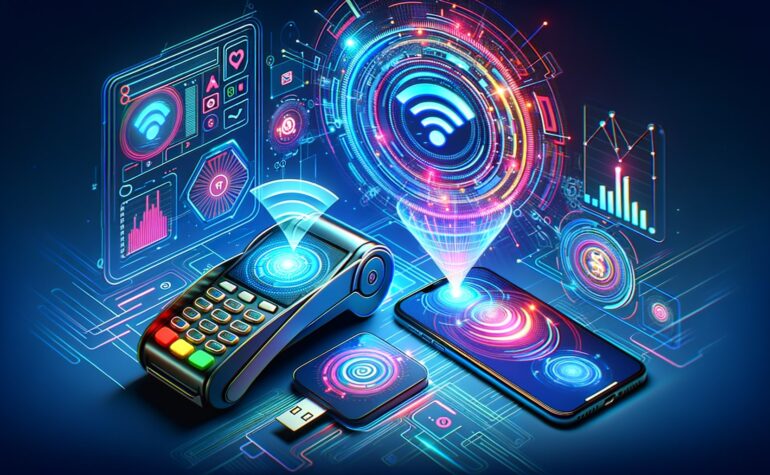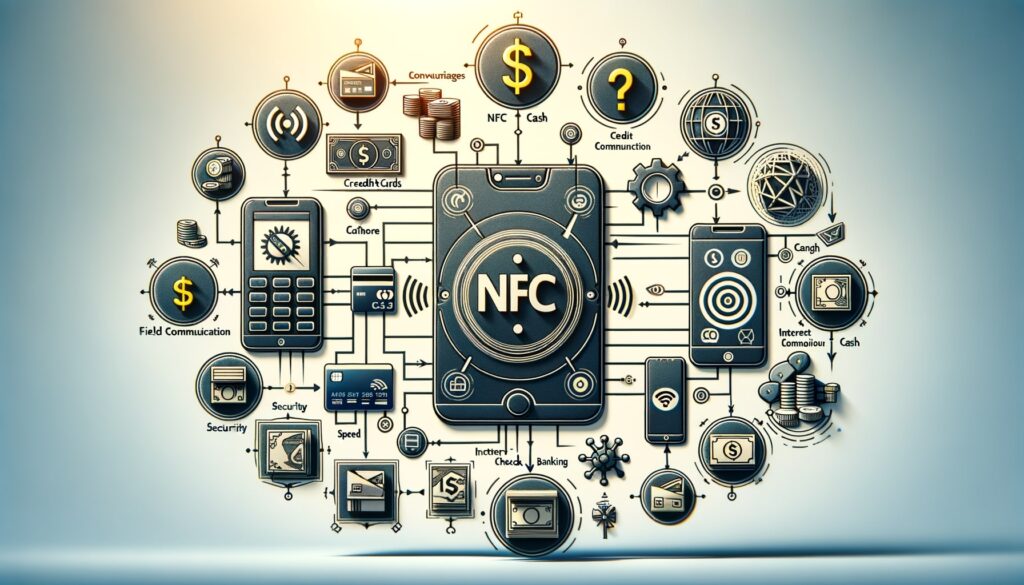Best Credit Card Processing Solutions Tailored for Every Industry

By admin November 16, 2024
In today’s fast-paced world, convenience is key. From ordering groceries online to streaming movies on demand, consumers are constantly seeking ways to simplify their lives. One area where this desire for convenience is particularly evident is in the realm of payments. Gone are the days of fumbling for cash or swiping a credit card. Instead, contactless payments, enabled by Near Field Communication (NFC) technology, have emerged as a popular and efficient way to make transactions.
Near Field Communication technology allows for the seamless transfer of data between two devices in close proximity, typically within a few centimeters. This technology has revolutionized the way we make payments, making it possible to complete transactions with just a tap or wave of a smartphone or contactless card.
In this article, we will explore the intricacies of NFC and contactless payments, including how Near Field Communication technology works, the benefits of contactless payments, security measures in place, popular Near Field Communication-enabled devices and payment systems, setting up and using NFC payments, differences between NFC and other payment technologies, common concerns and FAQs, and future trends and innovations in Near Field Communication technology.
How NFC Technology Works

Near Field Communication technology relies on electromagnetic fields to establish communication between two devices. It operates on the principle of magnetic induction, where an electrical current is generated when two coils come into close proximity. In the case of NFC, one coil is located in the transmitting device, such as a smartphone or contactless card, while the other coil is located in the receiving device, such as a payment terminal.
When a user initiates a contactless payment, the transmitting device emits a radio frequency signal that contains the necessary payment information. This signal is picked up by the receiving device, which then processes the payment and completes the transaction. The entire process happens in a matter of seconds, making NFC payments incredibly fast and convenient.
Benefits of Contactless Payments

Contactless payments offer a range of benefits for both consumers and merchants. For consumers, the primary advantage is convenience. With Near Field Communication-enabled devices, such as smartphones or contactless cards, users can simply tap or wave their device near a payment terminal to complete a transaction. This eliminates the need to carry cash or search for a credit card, streamlining the payment process and saving valuable time.
In addition to convenience, contactless payments also offer enhanced security. Unlike traditional magnetic stripe cards, which can be easily cloned or skimmed, NFC-enabled devices use dynamic encryption to protect payment information. Each transaction generates a unique code, making it virtually impossible for hackers to intercept and replicate the data. This added layer of security provides peace of mind for consumers, reducing the risk of fraud and unauthorized transactions.
For merchants, contactless payments offer increased efficiency and reduced transaction times. With Near Field Communication-enabled payment terminals, customers can complete transactions quickly, allowing for faster checkout lines and improved customer satisfaction. Additionally, contactless payments eliminate the need for physical cash handling, reducing the risk of theft and providing a more hygienic payment option, especially in light of the COVID-19 pandemic.
Security Measures in NFC and Contactless Payments

While contactless payments offer enhanced security compared to traditional payment methods, it is important to understand the security measures in place to protect sensitive information. One of the key security features of Near Field Communication technology is tokenization. When a user adds their payment card to a digital wallet, such as Apple Pay or Google Pay, the card details are replaced with a unique token. This token is then used for transactions, ensuring that the actual card information is never transmitted or stored on the device or payment terminal.
Additionally, Near Field Communication payments utilize encryption to protect data during transmission. This means that even if a hacker were to intercept the communication between the transmitting and receiving devices, they would not be able to decipher the encrypted data. Furthermore, NFC-enabled devices require authentication, such as a fingerprint or PIN, to authorize a payment. This adds an extra layer of security, ensuring that only the authorized user can initiate a transaction.
To further enhance security, payment networks and financial institutions have implemented fraud detection systems that monitor transactions for suspicious activity. These systems use advanced algorithms and machine learning to analyze patterns and identify potential fraudulent transactions. If a transaction is flagged as suspicious, additional verification steps may be required, such as entering a one-time passcode or answering security questions.
Overall, the combination of tokenization, encryption, authentication, and fraud detection systems make NFC and contactless payments highly secure. However, it is still important for users to take precautions, such as regularly updating their device’s software, using strong passwords or biometric authentication, and monitoring their transaction history for any unauthorized activity.
Popular NFC-enabled Devices and Payment Systems
Near Field Communication technology has gained widespread adoption, with a growing number of devices and payment systems supporting contactless payments. One of the most popular NFC-enabled devices is the smartphone. Both Android and iOS devices have built-in Near Field Communication capabilities, allowing users to make payments using digital wallets, such as Google Pay, Apple Pay, or Samsung Pay. These digital wallets securely store payment card information and can be used at any NFC-enabled payment terminal.
In addition to smartphones, contactless cards have become increasingly prevalent. These cards, also known as “tap-and-go” cards, have an embedded NFC chip that allows for contactless payments. Users can simply tap their card on a payment terminal to complete a transaction, without the need for a PIN or signature. Contactless cards are widely accepted at merchants around the world and are issued by various financial institutions.
Apart from smartphones and contactless cards, wearable devices, such as smartwatches and fitness trackers, are also equipped with Near Field Communication technology. These devices can be linked to digital wallets, enabling users to make payments with a simple flick of the wrist. Wearable devices offer the added convenience of not needing to carry a smartphone or wallet, making them ideal for active individuals or those who prefer a minimalist approach.
Setting Up and Using NFC Payments
Setting up and using NFC payments is a straightforward process that can be completed in a few simple steps. To begin, users need to ensure that their device supports Near Field Communication and that it is enabled. Most modern smartphones have NFC capabilities, but it is always a good idea to check the device’s specifications or settings menu to confirm.
Once Near Field Communication is enabled, users can add their payment cards to a digital wallet. This can typically be done by opening the wallet app on the device and following the prompts to add a card. Users will need to enter their card details, such as the card number, expiration date, and security code. Some digital wallets also support scanning the card using the device’s camera, making the setup process even more convenient.
After the card is added to the digital wallet, users may need to verify their identity. This can be done through various methods, such as entering a one-time passcode sent via SMS or email, answering security questions, or using biometric authentication, such as a fingerprint or facial recognition. Once the identity is verified, the card is ready to be used for Near Field Communication payments.
To make a payment, users simply need to unlock their device and hold it near an Near Field Communication-enabled payment terminal. The device will automatically detect the terminal and prompt the user to authorize the payment. This can be done by either placing a finger on the fingerprint sensor or entering a PIN. Once authorized, the payment is processed, and a confirmation message is displayed on the device and the payment terminal.
Differences Between NFC and Other Payment Technologies

While NFC technology has gained significant popularity, it is important to understand the differences between Near Field Communication and other payment technologies, such as QR codes and magnetic stripe cards. Each technology has its own strengths and weaknesses, and understanding these differences can help users make informed decisions when it comes to choosing a payment method.
One key difference between Near Field Communication and QR codes is the method of communication. NFC relies on close proximity and electromagnetic fields to establish communication between devices, while QR codes use visual scanning to transmit data. NFC payments are typically faster and more convenient, as users can simply tap or wave their device near a payment terminal. QR code payments, on the other hand, require users to open a payment app, scan the QR code displayed on the terminal, and confirm the payment.
Another difference is the level of security. NFC payments offer enhanced security compared to QR code payments, as Near Field Communication-enabled devices use encryption and tokenization to protect payment information. QR codes, on the other hand, can be easily intercepted or scanned by malicious actors, potentially compromising sensitive data. However, it is worth noting that both NFC and QR code payments are generally considered secure, and the risk of fraud is relatively low.
When comparing Near Field Communication to magnetic stripe cards, the main difference lies in the method of data transmission. Near Field Communication payments use wireless communication, while magnetic stripe cards require physical contact with a card reader. NFC payments are faster and more convenient, as users can simply tap their device on a payment terminal. Magnetic stripe cards, on the other hand, require users to swipe the card through a reader, which can be prone to wear and tear and may not be accepted at all payment terminals.
In terms of security, NFC payments offer superior protection compared to magnetic stripe cards. Magnetic stripe cards store static data on a magnetic stripe, making them vulnerable to cloning or skimming. Near Field Communication-enabled devices, on the other hand, use dynamic encryption and tokenization, making it extremely difficult for hackers to replicate payment information. This added layer of security reduces the risk of fraud and unauthorized transactions.
Future Trends and Innovations in Near Field Communication Technology
As NFC technology continues to evolve, there are several future trends and innovations that are shaping the future of contactless payments. One of the key trends is the integration of Near Field Communication technology into everyday objects, also known as the Internet of Things (IoT). This means that devices such as smart home appliances, wearables, and even cars can be equipped with NFC capabilities, allowing for seamless and secure payments.
Another trend is the expansion of NFC payments beyond traditional retail environments. Near Field Communication technology is being integrated into public transportation systems, allowing users to pay for fares with a simple tap of their device. Additionally, NFC-enabled devices can be used for access control, such as unlocking doors or accessing secure areas, further enhancing convenience and security.
In terms of innovations, biometric authentication is expected to play a significant role in the future of Near Field Communication payments. Facial recognition and fingerprint scanning are already being used to authenticate payments, but advancements in biometric technology may enable more secure and seamless authentication methods. For example, voice recognition or iris scanning could be used to authorize payments, eliminating the need for physical contact or PIN entry.
Furthermore, the rise of blockchain technology may have implications for NFC payments. Blockchain, a decentralized and transparent ledger, has the potential to enhance security and reduce transaction costs. By integrating Near Field Communication technology with blockchain, users could benefit from increased privacy, reduced fraud, and faster settlement times.
FAQs
Q1. What is Near Field Communication technology?
Near Field Communication technology allows for the seamless transfer of data between two devices in close proximity, typically within a few centimeters. It operates on the principle of magnetic induction, where an electrical current is generated when two coils come into close proximity.
Q2. How does Near Field Communication technology work?
When a user initiates a contactless payment, the transmitting device emits a radio frequency signal that contains the necessary payment information. This signal is picked up by the receiving device, which then processes the payment and completes the transaction.
Q3. What are the benefits of contactless payments?
Contactless payments offer convenience, enhanced security, increased efficiency, and reduced transaction times. Users can complete transactions quickly with just a tap or wave of their device, eliminating the need for cash or physical cards.
Q4. How secure are Near Field Communication and contactless payments?
Near Field Communication payments utilize encryption, tokenization, authentication, and fraud detection systems to protect sensitive information. Each transaction generates a unique code, making it virtually impossible for hackers to intercept and replicate the data.
Q5. What devices support NFC payments?
NFC payments are supported by smartphones, contactless cards, and wearable devices such as smartwatches and fitness trackers. Both Android and iOS devices have built-in Near Field Communication capabilities, and contactless cards are issued by various financial institutions.
Q6. How do I set up and use NFC payments?
To set up NFC payments, users need to ensure that their device supports NFC and that it is enabled. They can then add their payment cards to a digital wallet and verify their identity. To make a payment, users simply need to unlock their device and hold it near an Near Field Communication-enabled payment terminal.
Conclusion
NFC and contactless payments have revolutionized the way we make transactions. With their speed, convenience, and enhanced security, they have become a popular choice for consumers and businesses alike. The technology behind NFC payments, with its electromagnetic induction and secure element storage, ensures that transactions are completed quickly and securely. Popular Near Field Communication-enabled devices and payment systems, such as smartphones and contactless cards, have made it easier than ever to make contactless payments.
By understanding the differences between Near Field Communication and other payment technologies, users can make informed decisions about which method best suits their needs. As technology continues to advance, NFC and contactless payments are likely to become even more prevalent, offering even greater convenience and security in the future.
